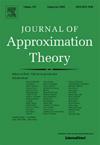Twenty-five years of greedy bases
IF 0.6
3区 数学
Q2 MATHEMATICS
引用次数: 0
Abstract
Although the basic idea behind the concept of a greedy basis had been around for some time, the formal development of a theory of greedy bases was initiated in 1999 with the publication of the article [S.V. Konyagin and V.N. Temlyakov, A remark on greedy approximation in Banach spaces, East J. Approx. 5 (3) (1999), 365-379]. The theoretical simplicity of the thresholding greedy algorithm became a model for a procedure widely used in numerical applications and the subject of greedy bases evolved very rapidly from the point of view of approximation theory. The idea of studying greedy bases and related greedy algorithms attracted also the attention of researchers with a classical Banach space theory background. From the more abstract point of functional analysis, the theory of greedy bases and its derivates evolved very fast as many fundamental results were discovered and new ramifications branched out. Hundreds of papers on greedy-like bases and several monographs have been written since the appearance of the aforementioned foundational paper. After twenty-five years, the theory is very much alive and it continues to be a very active research topic both for functional analysts and for researchers interested in the applied nature of nonlinear approximation alike. This is why we believe it is a good moment to gather a selection of 25 open problems (one per year since 1999!) whose solution would contribute to advance the state of art of this beautiful topic.
25年的贪婪基地
尽管贪婪基概念背后的基本思想已经存在了一段时间,但贪婪基理论的正式发展是在1999年发表的文章[S.V.孔雅金和V.N. Temlyakov,关于Banach空间贪心逼近的评论[j].数学学报,5(3)(1999),365-379。阈值贪心算法的理论简单性成为数值应用中广泛使用的一个过程的模型,从近似理论的角度来看,贪心基的主题发展得非常迅速。研究贪心基及相关贪心算法的思想也引起了具有经典巴拿赫空间理论背景的研究人员的关注。从更抽象的泛函分析的角度来看,贪婪基理论及其衍生理论的发展非常迅速,因为许多基本的结果被发现,新的分支分支也出现了。自从上述基础论文出现以来,已经有数百篇关于贪婪的基础的论文和几本专著被写了出来。经过25年的发展,这一理论非常活跃,对于泛函分析人员和对非线性近似的应用性质感兴趣的研究人员来说,它仍然是一个非常活跃的研究课题。这就是为什么我们认为现在是收集25个开放问题的好时机(自1999年以来每年一个!),这些问题的解决方案将有助于推进这一美丽主题的艺术状态。
本文章由计算机程序翻译,如有差异,请以英文原文为准。
求助全文
约1分钟内获得全文
求助全文
来源期刊
CiteScore
1.90
自引率
11.10%
发文量
55
审稿时长
6-12 weeks
期刊介绍:
The Journal of Approximation Theory is devoted to advances in pure and applied approximation theory and related areas. These areas include, among others:
• Classical approximation
• Abstract approximation
• Constructive approximation
• Degree of approximation
• Fourier expansions
• Interpolation of operators
• General orthogonal systems
• Interpolation and quadratures
• Multivariate approximation
• Orthogonal polynomials
• Padé approximation
• Rational approximation
• Spline functions of one and several variables
• Approximation by radial basis functions in Euclidean spaces, on spheres, and on more general manifolds
• Special functions with strong connections to classical harmonic analysis, orthogonal polynomial, and approximation theory (as opposed to combinatorics, number theory, representation theory, generating functions, formal theory, and so forth)
• Approximation theoretic aspects of real or complex function theory, function theory, difference or differential equations, function spaces, or harmonic analysis
• Wavelet Theory and its applications in signal and image processing, and in differential equations with special emphasis on connections between wavelet theory and elements of approximation theory (such as approximation orders, Besov and Sobolev spaces, and so forth)
• Gabor (Weyl-Heisenberg) expansions and sampling theory.

 求助内容:
求助内容: 应助结果提醒方式:
应助结果提醒方式:


